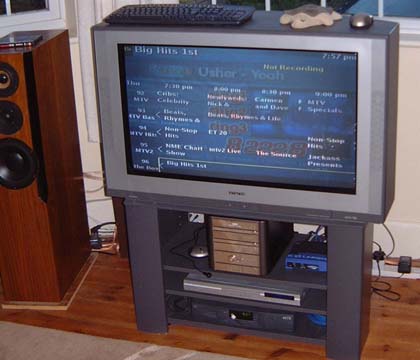What?
A MythTV Personal Video Recorder boxWhen?
Spring 2004Why?
The TiVo broke.How?
In order to replace the TiVo, we needed something capable of full PVR functionality. We needed to be able to pause live TV, pre-record shows and access all these features through an intuitive interface. The TiVo of course had all these things, but for some inexplicable reason is no longer available for purchase in the UK, so we had to look elsewhere.There are a couple of Linux-based projects with a suitable feature-list, and of these we chose MythTV. As well as the basic PVR-type stuff, MythTV supports mp3 playback, Web browsing, weather forecasts and a nice image gallery, so it has more than enough widgets to play with. Even better, it doesn't require a ten pound a month fee for the TV listings, which it scrapes through XMLTV instead.
What it does require is a fairly hefty PC spec., and a lot of configuration. We opted for the Hauppage PVR350 video encoder/decoder as the core of our system, on the basis that it could encode and decode video streams with virtually zero processor overhead. That meant that the 1.6 GHz AMD Athlon was more than adequate for the task. Plonk this into a nice little Mini-ITX box from Soltek, bolt on a 160Gb hard disk and that forms the basis for the system.
Actual configuration was relaitvely straightforwards, largely thanks to the excellent How-To. We followed the basic recipe of installing Red Hat Fedora Core 1, apt, etc., and encountered no problems. The only complication was dealing with NTL's awkward cable box, which only accepts ridiculously high-frequency IR signals (IRDA instead of Consumer IR). This required a Red-Eye IR transmitter to be hooked up to the box' serial port, and a little bit of scripting to get it to change channels in the right way. Infra-red reception was taken care of by the Hauppage card, which comes with a little remote control (hopefully soon to be replaced by a Pronto...).
Initially, we set up the card to use the PVR-350's TV output, as it should be slightly higher quality and also avoids using CPU cycles for decompression. However, in use, we found the framebuffer drivers to be very unstable, rarely staying up for longer than a day at a time (and, once, causing a reboot during the first four minutes of 24 - nooooo!). It also would have required some over-complex re-routing of audio signals to enable mp3 playback and video audio to end up in the same place, so we switched back to using the motherboard's TV-out. This seems to have slight issues with jerky playback, but I'm confident that they can be resolved with a bit of settings tweakage.
The other downside to this system is that it's surprisingly noisy - I was assured that the Soltek ITX box was a very quiet one, but its two fans are distinctly noticeable even in "silent" mode. Perhaps I should water cool it.
Basic data on what the box is doing can be seen on the living room's LCD module.
The box has been named "Hermes", after everyone's favourite Jamaican bureaucrat.


